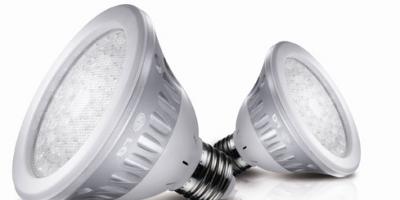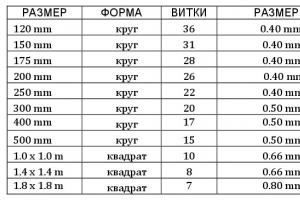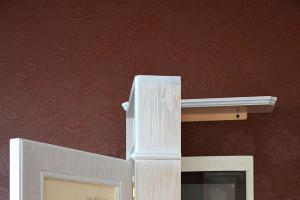Inner lining of the eye - retina(retina) plays the role of a peripheral receptor section of the visual analyzer.
The retina develops, as already mentioned, from a protrusion of the wall of the anterior medullary bladder. This gives grounds to consider it as true brain tissue, brought to the periphery.
The retina lines the entire inner surface of the choroid. According to the structure and functions, two departments are distinguished in it. The posterior two-thirds of the retina is highly differentiated neural tissue, the visual portion of the retina, which extends from the optic nerve to the serratus margin.
The visual part of the retina is connected to the underlying tissues in two places - at the serratus margin and around the optic nerve. The rest of the retina is adjacent to the choroid, held in place by the pressure of the vitreous body and a fairly intimate connection between the rods, cones and processes of the cells of the pigment layer. This connection is easily disrupted under pathological conditions and retinal detachment occurs.
The location where the optic nerve exits the retina is called the optic disc. At a distance of about 4 mm outward from the optic nerve head there is a depression - the so-called macula, or macula.


Optic disc Macula of the retina
The thickness of the retina near the disc is 0.4 mm, in the area of the macula - 0.1-0.05 mm, at the dentate line - 0.1 mm.
Microscopically, the retina is a chain of three neurons: outer - photoreceptor, middle - associative and internal - ganglion. Together they form 10 layers of the retina (Figure 1.9): 1) layer of pigment epithelium; 2) layer of rods and cones; 3) outer glial limiting membrane; 4) outer granular layer; 5) outer mesh layer; 6) internal granular layer; 7) inner mesh layer; 8) ganglion layer; 9) layer of nerve fibers; 10) internal glial limiting membrane. The nuclear and ganglion layers correspond to the bodies of neurons, and the reticular layers correspond to their contacts.


Rice. 1.9 Structure of the retina (diagram)
I – pigment epithelium; II – layer of rods and cones; III – external glial limiting membrane; IV – outer granular layer; V – outer mesh layer; VI – internal granular layer; VII – inner mesh layer; VIII – ganglion layer; IX – layer of nerve fibers; X – internal glial limiting membrane; XI – vitreous body
A ray of light, before hitting the photosensitive layer of the retina, must pass through the transparent media of the eye: the cornea, lens, vitreous body and the entire thickness of the retina. Rod and cone photoreceptors are the deepest parts of the retina. Therefore, the human retina is of the inverted type.
The outermost layer of the retina is the pigment layer. Pigment epithelial cells have the shape of hexagonal prisms arranged in one row. The cell bodies are filled with grains of pigment - fuscin, which differs from the pigment of the choroid - melanin. Genetically, the pigment epithelium belongs to the retina, but is tightly fused to the choroid.

Retinal pigment epithelium
From the inside, neuroepithelial cells (the first neuron of the visual analyzer) are adjacent to the pigment epithelium, the processes of which - rods and cones - make up the photosensitive layer. Both in structure and in physiological significance, these processes differ from each other. The sticks are cylindrical and thin. Cones are cone- or bottle-shaped, shorter and thicker than rods.

Rods and cones
The rods and cones are arranged in a palisade, unevenly. The area of the macula contains only cones. Towards the periphery, the number of cones decreases and the number of rods increases. The number of rods significantly exceeds the number of cones: if there can be up to 8 million cones, then up to 170 million rods.

Rods and cones in the retina
She is very complex. In the outer segments of rods and cones, discs that carry out photochemical processes are concentrated, as indicated by the increased concentration of rhodopsin in rod discs and iodopsin in cone discs. Adjacent to the outer segments of the rods and cones is a cluster of mitochondria, which are believed to participate in the energy metabolism of the cell. Rod-bearing visual cells are the apparatus of twilight vision, cone-bearing cells are the apparatus of central and color vision.

Cone (left) and rod (right): 1 – presynaptic contact; 2 – core; 3 – liposomes; 4 – mitochondria; 5 – internal segment; 6 – outer segment
The nuclei of rod- and cone-bearing visual cells make up the outer granular layer, which is located inward from the outer glial limiting membrane.
The connection between the first and second neurons is provided by synapses located in the outer reticular, or plexiform, layer. In the transmission of nerve impulses, chemical substances play a role - mediators (in particular, acetylcholine), which accumulate in synapses.
The inner granular layer is represented by the bodies and nuclei of bipolar neurocytes (the second neuron of the visual analyzer). These cells have two processes: one of them is directed outward, towards the synaptic apparatus of photosensory cells, the other is directed inward to form a synapse with the dendrites of optic ganglion cells. Bipolars come into contact with several rod cells, while each cone cell contacts one bipolar cell, which is especially pronounced in the macular region.
The inner reticular layer is represented by synapses of bipolar and opto-ganglionic neurocytes.
Optico-ganglionic cells (the third neuron of the visual analyzer) make up the eighth layer. The body of these cells is rich in protoplasm, contains a large nucleus, has highly branching dendrites and one axon - a cylinder. The axons form a layer of nerve fibers and, gathering into a bundle, form the trunk of the optic nerve.
Supporting tissue is represented by neuroglia, boundary membranes and interstitial matter, which is essential in metabolic processes.
In the area of the spot, the structure of the retina changes. As the spot approaches the central fovea ( fovea centralis) the layer of nerve fibers disappears, then the layer of optic ganglion cells and the inner reticular layer, and finally the inner granular layer of the nucleus and the outer reticular layer. At the bottom of the fovea, the retina consists only of cone-bearing cells. The remaining elements seem to be shifted to the edge of the spot. This structure provides high central vision.

Fovea macula
A person sees not with his eyes, but through his eyes, from where information is transmitted through the optic nerve, chiasm, visual tracts to certain areas of the occipital lobes of the cerebral cortex, where the picture of the external world that we see is formed. All these organs make up our visual analyzer or visual system.
Having two eyes allows us to make our vision stereoscopic (that is, form a three-dimensional image). The right side of the retina in each eye transmits the “right side” of the image to the right side of the brain via the optic nerve, and the left side of the retina acts similarly. Then the brain connects two parts of the image - right and left - together.
Since each eye perceives “its own” picture, if the joint movement of the right and left eyes is disrupted, binocular vision may be disrupted. Simply put, you will begin to see double or see two completely different pictures at the same time.
Basic functions of the eye
- optical system that projects the image;
- a system that perceives and “encodes” the received information for the brain;
- "serving" life support system.
The eye can be called a complex optical device. Its main task is to “transmit” the correct image to the optic nerve.
Cornea- a transparent membrane covering the front of the eye. It lacks blood vessels and has great refractive power. Part of the optical system of the eye. The cornea borders the opaque outer layer of the eye, the sclera. See structure of the cornea.
Anterior chamber of the eye- This is the space between the cornea and the iris. It is filled with intraocular fluid.
Iris- shaped like a circle with a hole inside (pupil). The iris consists of muscles that, when contracted and relaxed, change the size of the pupil. It enters the choroid of the eye. The iris is responsible for the color of the eyes (if it is blue, it means there are few pigment cells, if it is brown, it means a lot). Performs the same function as the aperture in a camera, regulating the light flow.
Pupil- a hole in the iris. Its size usually depends on the light level. The more light, the smaller the pupil.
Lens- the “natural lens” of the eye. It is transparent, elastic - it can change its shape, almost instantly “focusing”, due to which a person sees well both near and far. Located in the capsule, held ciliary girdle. The lens, like the cornea, is part of the optical system of the eye.
Vitreous body- a gel-like transparent substance located in the back of the eye. The vitreous body maintains the shape of the eyeball and is involved in intraocular metabolism. Part of the optical system of the eye.
Retina- consists of photoreceptors (they are sensitive to light) and nerve cells. Receptor cells located in the retina are divided into two types: cones and rods. In these cells, which produce the enzyme rhodopsin, the energy of light (photons) is converted into electrical energy in nervous tissue, i.e. a photochemical reaction.
Rods are highly photosensitivity and allow you to see in low light; they are also responsible for peripheral vision. Cones, on the contrary, require more light for their work, but they allow you to see small details (responsible for central vision) and make it possible to distinguish colors. The largest concentration of cones is located in the central fossa (macula), which is responsible for the highest visual acuity. The retina is adjacent to the choroid, but in many areas it is loose. This is where it tends to peel off in various retinal diseases.
Sclera- the opaque outer layer of the eyeball, which in front of the eyeball turns into a transparent cornea. 6 extraocular muscles are attached to the sclera. It contains a small number of nerve endings and blood vessels.
Choroid— lines the posterior part of the sclera, the retina is adjacent to it, with which it is closely connected. The choroid is responsible for the blood supply to intraocular structures. In diseases of the retina, it is very often involved in the pathological process. There are no nerve endings in the choroid, so when it is diseased, there is no pain, which usually signals some kind of problem.
Optic nerve- using the optic nerve, signals from nerve endings are transmitted to the brain.
The eyeball has 2 poles: posterior and anterior. The distance between them is on average 24 mm. It is the largest size of the eyeball. The bulk of the latter is made up of the inner core. This is a transparent content that is surrounded by three shells. It consists of aqueous humor, the lens and the nucleus of the eyeball is surrounded on all sides by the following three membranes of the eye: fibrous (outer), vascular (middle) and reticular (inner). Let's talk about each of them.
Outer shell
The most durable is the outer shell of the eye, fibrous. It is thanks to her that the eyeball is able to maintain its shape.
Cornea
The cornea, or cornea, is its smaller, anterior section. Its size is about 1/6 the size of the entire shell. The cornea is the most convex part of the eyeball. In appearance, it is a concave-convex, somewhat elongated lens, which faces backward with a concave surface. About 0.5 mm is the approximate thickness of the cornea. Its horizontal diameter is 11-12 mm. As for the vertical one, its size is 10.5-11 mm.

The cornea is the transparent membrane of the eye. It contains a transparent connective tissue stroma, as well as corneal corpuscles that form its own substance. The posterior and anterior border plates are adjacent to the stroma on the posterior and anterior surfaces. The latter is the main substance of the cornea (modified), while the other is a derivative of the endothelium, which covers its posterior surface and also lines the entire anterior chamber of the human eye. Stratified epithelium covers the anterior surface of the cornea. It passes without sharp boundaries into the epithelium of the connective membrane. Due to the homogeneity of the tissue, as well as the absence of lymphatic and blood vessels, the cornea, unlike the next layer, which is the white membrane of the eye, is transparent. Let us now move on to the description of the sclera.
Sclera

The white membrane of the eye is called the sclera. This is the larger, posterior section of the outer shell, making up about 1/6 of it. The sclera is a direct continuation of the cornea. However, unlike the latter, it is formed by fibers of connective tissue (dense) with an admixture of other fibers - elastic. The white membrane of the eye is also opaque. The sclera gradually passes into the cornea. A translucent rim is located on the border between them. It is called the edge of the cornea. Now you know what the white membrane of the eye is like. It is transparent only at the very beginning, near the cornea.
Sections of the sclera
In the anterior section, the outer surface of the sclera is covered with the conjunctiva. These are the eyes. Otherwise it is called connective tissue. As for the posterior section, here it is covered only by the endothelium. The inner surface of the sclera, which faces the choroid, is also covered by endothelium. The sclera is not the same in thickness throughout its entire length. The thinnest section is the place where it is pierced by the fibers of the optic nerve, which exits the eyeball. Here the cribriform plate is formed. The sclera is thickest around the optic nerve. It ranges from 1 to 1.5 mm here. Then the thickness decreases, reaching 0.4-0.5 mm at the equator. Moving to the area of muscle attachment, the sclera thickens again, its length here is about 0.6 mm. Not only optic nerve fibers pass through it, but also venous and arterial vessels, as well as nerves. They form a series of openings in the sclera, which are called scleral graduates. Near the edge of the cornea, in the depths of its anterior section, the scleral sinus lies along its entire length, running circularly.
Choroid

So, we have briefly characterized the outer shell of the eye. We now turn to the vascular characteristic, which is also called average. It is divided into the following 3 unequal parts. The first of these is the large, posterior one, which lines about two-thirds of the inner surface of the sclera. It is called the choroid proper. The second part is the middle one, located on the border between the cornea and sclera. This And finally, the third part (smaller, anterior), visible through the cornea, is called the iris, or iris.
The choroid proper of the eye passes without sharp boundaries in the anterior sections into the ciliary body. The jagged edge of the wall can act as a boundary between them. Almost throughout its entire length, the choroid itself is only adjacent to the sclera, except for the area of the spot, as well as the area that corresponds to the optic nerve head. The choroid in the region of the latter has an optic opening through which optic nerve fibers exit to the cribriform plate of the sclera. The rest of its outer surface is covered with pigment and it limits the perivascular capillary space together with the inner surface of the sclera.
The other layers of the membrane of interest to us are formed from a layer of large vessels that form the vascular plate. These are mainly veins, but also arteries. Connective tissue elastic fibers, as well as pigment cells, are located between them. The layer of middle vessels lies deeper than this layer. It is less pigmented. Adjacent to it is a network of small capillaries and vessels, forming a vascular-capillary plate. It is especially developed in the macula area. The structureless fibrous layer is the deepest zone of the choroid proper. It is called the main plate. In the anterior section, the choroid thickens slightly and passes without sharp boundaries into the ciliary body.
Ciliary body
It is covered on the inner surface with a main plate, which is a continuation of the leaf. The leaflet refers to the choroid proper. The bulk of the ciliary body consists of the ciliary muscle, as well as the stroma of the ciliary body. The latter is represented by connective tissue, rich in pigment cells and loose, as well as many vessels.
The following parts are distinguished in the ciliary body: the ciliary circle, the ciliary corolla and the ciliary muscle. The latter occupies its outer section and is adjacent directly to the sclera. The ciliary muscle is formed by smooth muscle fibers. Among them, circular and meridional fibers are distinguished. The latter are highly developed. They form a muscle that serves to stretch the choroid itself. Its fibers begin from the sclera and the angle of the anterior chamber. Heading posteriorly, they are gradually lost in the choroid. This muscle, contracting, pulls forward the ciliary body (its back part) and the choroid itself (the front part). Thus, the tension of the ciliary girdle decreases.
Ciliary muscle
Circular fibers are involved in the formation of the orbicularis muscle. Its contraction reduces the lumen of the ring, which is formed by the ciliary body. Thanks to this, the place of fixation to the equator of the lens of the ciliary band approaches. This causes the girdle to relax. In addition, the curvature of the lens increases. It is because of this that the circular part of the ciliary muscle is also called the muscle that compresses the lens.
Eyelash circle
This is the posterior internal part of the ciliary body. It is arched in shape and has an uneven surface. The ciliary circle continues without sharp boundaries in the choroid proper.
Ciliated corolla
It occupies the anterior internal part. It has small folds running radially. These ciliary folds pass anteriorly into ciliary processes, of which there are about 70 and which hang freely into the region of the posterior chamber of the apple. A rounded edge is formed in the place where the transition to the ciliary corolla of the ciliary circle is observed. This is the site of attachment of the fixing lens of the ciliary band.
Iris
The anterior part is the iris, or iris. Unlike other sections, it is not directly adjacent to the fibrous membrane. The iris is a continuation of the ciliary body (its anterior section). It is located in and somewhat distant from the cornea. A round hole called the pupil is located in its center. The ciliary margin is the opposite edge that runs along the entire circumference of the iris. The thickness of the latter consists of smooth muscles, blood vessels, connective tissue, as well as many nerve fibers. The pigment that determines the “color” of the eye is found in the cells of the posterior surface of the iris.

Its smooth muscles are located in two directions: radial and circular. A circular layer lies in the circumference of the pupil. It forms a muscle that constricts the pupil. The fibers arranged radially form the muscle that expands it.
The anterior surface of the iris is slightly convex anteriorly. Accordingly, the rear one is concave. On the front, in the circumference of the pupil, there is an internal small ring of the iris (pupillary belt). Its width is about 1 mm. The small ring is bounded on the outside by an irregular jagged line running circularly. It is called the small circle of the iris. The remaining part of its front surface is about 3-4 mm wide. It belongs to the outer large ring of the iris, or ciliary part.
Retina

We have not yet examined all the membranes of the eye. We presented fibrous and vascular. Which membrane of the eye has not yet been examined? The answer is internal, reticular (also called retina). This membrane is represented by nerve cells located in several layers. It lines the inside of the eye. This membrane of the eye is of great importance. It is she who provides a person with vision, since objects are displayed on it. Information about them is then transmitted to the brain via the optic nerve. However, the retina does not all see equally. The structure of the eye shell is such that the macula is characterized by the greatest visual ability.
Macula

It represents the central part of the retina. We all heard from school that the retina contains only cones, which are responsible for color vision. Without it, we would not be able to discern small details or read. The macula has all the conditions for recording light rays in the most detailed manner. The retina in this area becomes thinner. Thanks to this, light rays can hit the light-sensitive cones directly. There are no retinal vessels that can interfere with clear vision in the macula. Its cells receive nutrition from the choroid, located deeper. The macula is the central part of the retina of the eye, where the main number of cones (visual cells) are located.
What's inside the shells
Inside the membranes are the anterior and posterior chambers (between the lens and the iris). They are filled with liquid inside. Between them are the vitreous body and the lens. The latter is shaped like a biconvex lens. The lens, like the cornea, refracts and transmits light rays. Thanks to this, the image is focused on the retina. The vitreous body has the consistency of jelly. separated from the lens with its help.
Optic tract and optic chiasm.
Eyeball
The eyeball itself is located in the orbit, and is surrounded on the outside by protective soft tissues (muscle fibers, fatty tissue, nerve pathways). In front, the eyeball is covered with eyelids and the conjunctival membrane, which protect the eye.
The apple has three shells that divide the space inside the eye into the anterior and posterior chambers, as well as the vitreous chamber. The latter is completely filled with vitreous humor.
Fibrous (outer) layer of the eye
The outer shell consists of fairly dense connective tissue fibers. In its anterior section, the shell is presented, which has a transparent structure, and throughout the rest of it it is white in color and has an opaque consistency. Due to elasticity and elasticity, both of these shells create the shape of the eye.
Cornea
The cornea makes up about a fifth of the fibrous membrane. It is transparent, and at the point of transition to the opaque sclera it forms a limbus. The shape of the cornea is usually an ellipse, the dimensions of which in diameter are 11 and 12 mm, respectively. The thickness of this transparent shell is 1 mm. Due to the fact that all the cells in this layer are strictly oriented in the optical direction, this shell is completely transparent to light rays. In addition, the absence of blood vessels in it also plays a role.
The layers of the cornea can be divided into five, similar in structure:
- Anterior epithelial layer.
- Bowman's shell.
- Corneal stroma.
- Descemet's membrane.
- The posterior epithelial layer, called endothelium.
The cornea contains a large number of nerve receptors and endings, and therefore it is very sensitive to external influences. Due to the fact that it is transparent, the cornea allows light to pass through. However, at the same time, it refracts it, since it has enormous refractive power.
Sclera
The sclera refers to the opaque part of the outer fibrous membrane of the eye and has a white tint. The thickness of this layer is only 1 mm, but it is very strong and dense, as it consists of special fibers. A number of extraocular muscles are attached to it.
Choroid
The choroid is considered medium, and its composition mainly includes various vessels. It consists of three main components:
- The iris, which is located in front.
- Ciliary (ciliary) body, belonging to the middle layer.
- Actually, which is the back part.
The shape of this layer resembles a circle, inside of which there is a hole called the pupil. It also contains two orbicularis muscles, which provide optimal pupil diameter in different lighting conditions. In addition, it contains pigment cells that determine eye color. If there is little pigment, then the eye color is blue, if there is a lot, then brown. The main function of the iris is to regulate the thickness of the light flux, which passes into the deeper layers of the eyeball.
The pupil is an opening inside the iris, the size of which is determined by the amount of light in the external environment. The brighter the lighting, the narrower the pupil, and vice versa. The average pupil diameter is about 3-4 mm.
Choroid
The choroid is represented by the posterior region of the choroid and consists of veins, arteries and capillaries. Its main task is to deliver nutrients to the iris and ciliary body. Due to the large number of vessels, it has a red color and stains the fundus of the eye.
Retina
The reticular inner shell is the first section that belongs to the visual analyzer. It is in this shell that light waves are transformed into nerve impulses that distribute information to central structures. In the brain centers, the received impulses are processed and an image is created that is perceived by a person. The composition includes six layers of different fabrics.
The outer layer is pigmented. Due to the presence of pigment, it scatters light and absorbs it. The second layer consists of processes of retinal cells (cones and rods). These processes contain a large amount of rhodopsin (c) and iodopsin (c).
The most active part of the retina (optical) is visualized during fundus examination and is called the fundus. This area contains a large number of vessels, the optic disc, which corresponds to the exit of nerve fibers from the eye, and the macula. The latter is a special area of the retina in which the largest number of cones are located, which determine daytime color vision.
The apple has three shells that divide the space inside the eye into the anterior and posterior chambers, as well as the vitreous chamber.
Inner nucleus of the eye
Aqueous moisture
The intraocular fluid is located in the anterior chamber of the eye, surrounded by the cornea and iris, as well as in the posterior chamber, formed by the iris and lens. These cavities communicate with each other through the pupil, so fluid can move freely between them. The composition of this moisture is similar to blood plasma; its main role is nutritional (for the cornea and lens).
Lens
The lens is an important organ of the optical system, which consists of a semi-solid substance and does not contain blood vessels. It is presented in the form of a biconvex lens, on the outside of which there is a capsule. Lens diameter 9-10 mm, thickness 3.6-5 mm.
The lens is located in the recess behind the iris on the anterior surface of the vitreous body. The stability of the position is ensured by fixation using the ligaments of Zinn. From the outside, the lens is washed by the intraocular fluid, which nourishes it with various useful substances. The main role of the lens is refractive. Due to this, it promotes rays directly on the retina.
Vitreous body
In the posterior part of the eye, the vitreous body is localized, which is a gelatinous transparent mass similar in consistency to a gel. The volume of this chamber is 4 ml. The main component of the gel is water, as well as hyaluronic acid (2%). In the area of the vitreous body, fluid constantly moves, which allows nutrition to be delivered to the cells. Among the functions of the vitreous body it is worth noting: refractive, nourishing (for the retina), as well as maintaining the shape and tone of the eyeball.
Eye protective apparatus
Eye socket
The orbit is part of the skull and is the container for the eye. Its shape resembles a tetrahedral truncated pyramid, the top of which is directed inward (at an angle of 45 degrees). The base of the pyramid faces outward. The dimensions of the pyramid are 4 by 3.5 cm, and the depth reaches 4-5 cm. In the cavity of the orbit, in addition to the eyeball itself, there are muscles, choroid plexuses, a fatty body, and the optic nerve.
Eyelids
The upper and lower eyelids help protect the eye from external influences (dust, foreign particles, etc.). Due to the high sensitivity, when the cornea is touched, the eyelids immediately close tightly. Due to blinking movements, small foreign objects and dust are removed from the surface of the cornea, and tear fluid is distributed. During closure, the edges of the upper and lower eyelids are very tightly adjacent to each other, and additionally located along the edge. The latter also help protect the eyeball from dust.
The skin in the eyelid area is very delicate and thin, it gathers into folds. Under it there are several muscles: the levator of the upper eyelid and the orbicularis, which ensures rapid closure. The conjunctival membrane is located on the inner surface of the eyelids.
Conjunctiva
The conjunctival membrane has a thickness of about 0.1 mm and is represented by mucosal cells. It covers the eyelids, forms the fornix of the conjunctival sac, and then passes to the anterior surface of the eyeball. The conjunctiva ends at the limbus. If you close your eyelids, this mucous membrane forms a cavity that has the shape of a bag. With open eyelids, the volume of the cavity is significantly reduced. The function of the conjunctiva is primarily protective.
Lacrimal apparatus of the eye
The lacrimal apparatus includes the gland, canaliculi, lacrimal puncta and sac, as well as the nasolacrimal duct. The lacrimal gland is located in the area of the upper outer wall of the orbit. It secretes tear fluid, which penetrates through the channels into the eye area, and then into the lower conjunctival fornix.
After this, the tear, through the lacrimal puncta located in the area of the inner corner of the eye, enters the lacrimal sac through the lacrimal canals. The latter is located between the inner corner of the eyeball and the wing of the nose. From the bag, tears can flow through the nasolacrimal duct directly into the nasal cavity.
The tear itself is a rather salty, transparent liquid that has a slightly alkaline environment. A person produces about 1 ml of such liquid with a varied biochemical composition per day. The main functions of tears are protective, optical, and nutritional.
Muscular apparatus of the eye
The muscular system of the eye includes six extraocular muscles: two oblique, four rectus. There is also the levator superioris and the orbicularis oculi muscle. All these muscle fibers ensure the movement of the eyeball in all directions and the squinting of the eyelids.


The human eye is an amazing biological optical system. In fact, lenses enclosed in several shells allow a person to see the world around him in color and volume.
Here we will look at what the shell of the eye can be, how many shells the human eye is enclosed in and find out their distinctive features and functions.
The eye consists of three membranes, two chambers, and a lens and vitreous body, which occupies most of the inner space of the eye. In fact, the structure of this spherical organ is in many ways similar to the structure of a complex camera. Often the complex structure of the eye is called the eyeball.
The membranes of the eye not only hold the internal structures in a given shape, but also take part in the complex process of accommodation and supply the eye with nutrients. It is customary to divide all layers of the eyeball into three layers of the eye:
- Fibrous or outer membrane of the eye. Which consists of 5/6 opaque cells - the sclera and 1/6 of transparent cells - the cornea.
- Choroid. It is divided into three parts: the iris, the ciliary body and the choroid.
- Retina. It consists of 11 layers, one of which will be cones and rods. With their help, a person can distinguish objects.
Now let's look at each of them in more detail.
Outer fibrous membrane of the eye
This is the outer layer of cells that covers the eyeball. It is a support and at the same time a protective layer for the internal components. The anterior part of this outer layer is the cornea, which is strong, transparent and strongly concave. This is not only a shell, but also a lens that refracts visible light. The cornea refers to those parts of the human eye that are visible and are formed from clear, special transparent epithelial cells. The back part of the fibrous membrane - the sclera - consists of dense cells to which 6 muscles that support the eye are attached (4 straight and 2 oblique). It is opaque, dense, white in color (reminiscent of the white of a boiled egg). Because of this, its second name is the tunica albuginea. At the boundary between the cornea and sclera there is a venous sinus. It ensures the outflow of venous blood from the eye. There are no blood vessels in the cornea, but in the back of the sclera (where the optic nerve exits) there is a so-called lamina cribrosa. Through its openings pass blood vessels that supply the eye.
The thickness of the fibrous layer ranges from 1.1 mm at the edges of the cornea (in the center it is 0.8 mm) to 0.4 mm of the sclera in the area of the optic nerve. At the border with the cornea, the sclera is slightly thicker, up to 0.6 mm.

Damage and defects of the fibrous membrane of the eye
Among the diseases and injuries of the fibrous layer, the most common are:
- Damage to the cornea (conjunctiva), this can be a scratch, burn, hemorrhage.
- Contact with a foreign body (eyelash, grain of sand, larger objects) on the cornea.
- Inflammatory processes - conjunctivitis. Often the disease is infectious.
- Among diseases of the sclera, staphyloma is common. With this disease, the ability of the sclera to stretch is reduced.
- The most common will be episcleritis - redness, swelling caused by inflammation of the surface layers.
Inflammatory processes in the sclera are usually secondary in nature and are caused by destructive processes in other structures of the eye or from the outside.
Diagnosis of corneal disease is usually not difficult, since the degree of damage is determined visually by an ophthalmologist. In some cases (conjunctivitis), additional tests are required to detect infection.

Middle, choroid of the eye
Inside, between the outer and inner layers, the middle choroid is located. It consists of the iris, ciliary body and choroid. The purpose of this layer is defined as nutrition and protection and accommodation.
- Iris. The iris of the eye is a kind of diaphragm of the human eye; it not only takes part in the formation of the image, but also protects the retina from burns. In bright light, the iris narrows the space, and we see a very small point of the pupil. The less light, the larger the pupil and narrower the iris.
The color of the iris depends on the number of melanocyte cells and is determined genetically.
- Ciliary or ciliary body. It is located behind the iris and supports the lens. Thanks to it, the lens can quickly stretch and react to light and refract rays. The ciliary body takes part in the production of aqueous humor for the internal chambers of the eye. Another purpose is to regulate the temperature inside the eye.
- Choroid. The rest of this membrane is occupied by the choroid. Actually, this is the choroid itself, which consists of a large number of blood vessels and performs the functions of feeding the internal structures of the eye. The structure of the choroid is such that there are larger vessels on the outside, and smaller ones on the inside, and capillaries at the very border. Another of its functions will be the depreciation of internal unstable structures.
The choroid of the eye is equipped with a large number of pigment cells; it prevents the passage of light into the eye and thereby eliminates the scattering of light.
The thickness of the vascular layer is 0.2–0.4 mm in the area of the ciliary body and only 0.1–0.14 mm near the optic nerve.
Damage and defects of the choroid of the eye
The most common disease of the choroid is uveitis (inflammation of the choroid). Choroiditis is often encountered, which is combined with various types of retinal damage (chorioreditinitis).
More rare diseases such as:
- choroidal dystrophy;
- detachment of the choroid, this disease occurs when intraocular pressure changes, for example during ophthalmological operations;
- ruptures as a result of injuries and impacts, hemorrhage;
- tumors;
- nevi;
- Colobomas are the complete absence of this membrane in a certain area (this is a congenital defect).
Diagnosis of diseases is carried out by an ophthalmologist. The diagnosis is made as a result of a comprehensive examination.

The retina of the human eye is a complex structure of 11 layers of nerve cells. It does not include the anterior chamber of the eye and is located behind the lens (see picture). The topmost layer consists of light-sensitive cone and rod cells. Schematically, the arrangement of layers looks approximately as in the figure.

All these layers represent a complex system. Here the perception of light waves occurs, which are projected onto the retina by the cornea and lens. With the help of nerve cells in the retina, they are converted into nerve impulses. And then these nerve signals are transmitted to the human brain. This is a complex and very fast process.
The macula plays a very important role in this process; its second name is the yellow spot. Here the transformation of visual images and the processing of primary data occurs. The macula is responsible for central vision in daylight.
This is a very heterogeneous shell. So, near the optic disc it reaches 0.5 mm, while in the fovea of the macula it is only 0.07 mm, and in the central fovea up to 0.25 mm.

Damage and defects of the inner retina of the eye
Among injuries to the human retina, at the everyday level, the most common burn is from skiing without protective equipment. Diseases such as:
- retinitis is an inflammation of the membrane, which occurs as an infectious disease (purulent infections, syphilis) or of an allergic nature;
- retinal detachments, which occur when the retina is depleted and torn;
- age-related macular degeneration, which affects the cells of the center - the macula. It is the most common cause of vision loss in patients over 50 years of age;
- retinal dystrophy - this disease most often affects older people; it is associated with thinning of the layers of the retina; at first, its diagnosis is difficult;
- retinal hemorrhage also occurs as a result of aging in older people;
- diabetic retinopathy. It develops 10–12 years after diabetes and affects the nerve cells of the retina.
- Tumor formations on the retina are also possible.
Diagnosis of retinal diseases requires not only special equipment, but also additional examinations.
Treatment of diseases of the retinal layer of the eye of an elderly person usually has a cautious prognosis. At the same time, diseases caused by inflammation have a more favorable prognosis than those associated with the aging process of the body.

Why is the mucous membrane of the eye needed?
The eyeball is located in the eye orbit and securely fixed. Most of it is hidden, only 1/5 of the surface—the cornea—transmits light rays. From above, this part of the eyeball is closed by eyelids, which, when opened, form a gap through which light passes. The eyelids are equipped with eyelashes that protect the cornea from dust and external influences. Eyelashes and eyelids are the outer layer of the eye.
The mucous membrane of the human eye is the conjunctiva. The inside of the eyelids is lined with a layer of epithelial cells that form the pink layer. This layer of delicate epithelium is called the conjunctiva. The cells of the conjunctiva also contain lacrimal glands. The tears they produce not only moisturize the cornea and prevent it from drying out, but also contain bactericidal and nutrient substances for the cornea.
The conjunctiva has blood vessels that connect to the vessels of the face and has lymph nodes that serve as outposts for infection.
Thanks to all the membranes, the human eye is reliably protected and receives the necessary nutrition. In addition, the membranes of the eye take part in the accommodation and transformation of the information received.
The onset of the disease or other damage to the membranes of the eye can cause loss of visual acuity.








